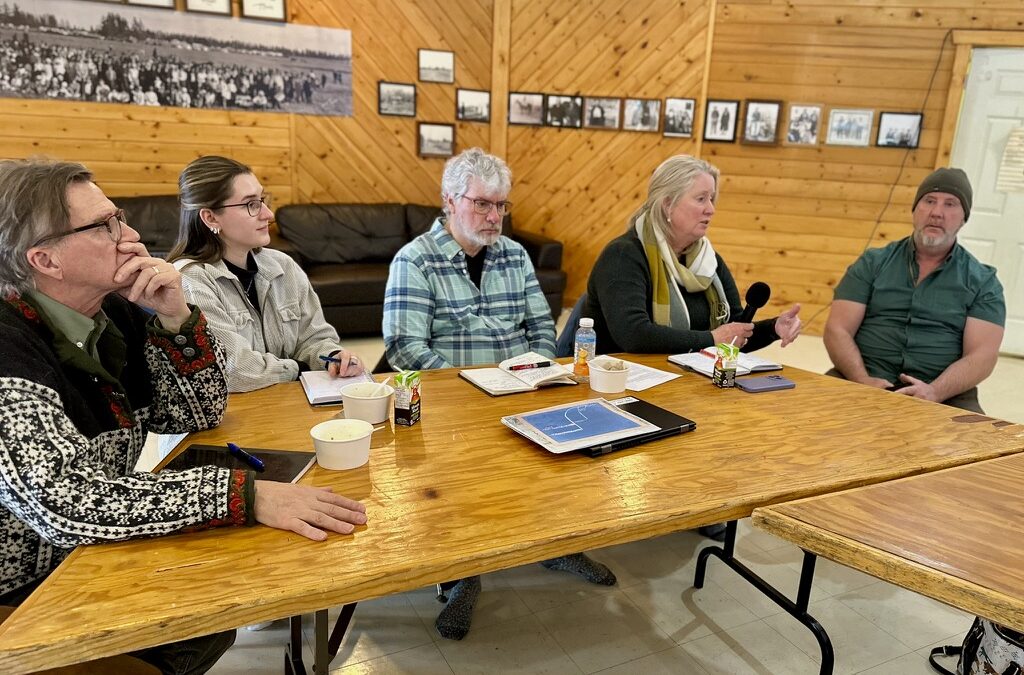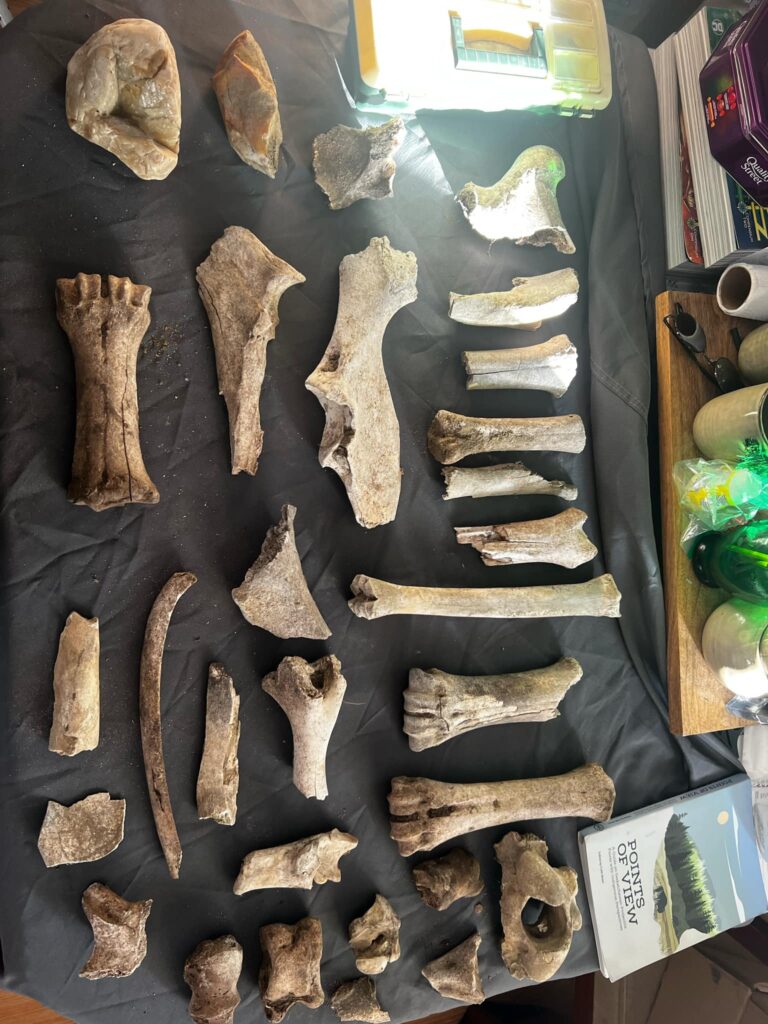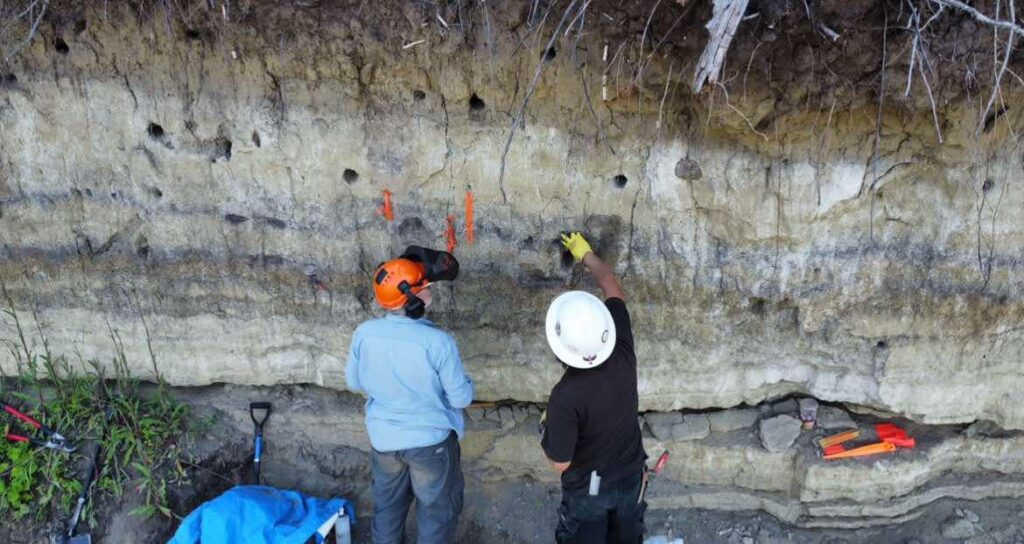(Photo: from left to right Butch Amundson, Jayda Boux, Dr. Stuart, Dr. Freeman, and Dave Rondeau. Provided by Tina Pelletier)
Archeologists from the University of Saskatchewan and the University of Calgary visited Sturgeon Lake First Nation (SLFN) on Friday, January 31, for an exciting announcement.
Dave Rondeau, a researcher and avocational archeologist from Crutwell, discovered an ancient campsite in the Nisbet Forest, which is estimated to be approximately 10,650-10,800 years old.
The site, which is named Âsowanânihk, is located along the riverbank where overtime natural forces caused the bank to erode, revealing layers of history. Through Rondeau’s research, along with the help of several archeologists, they located remnants of bison bones, fire pits, and ancient tools.
“The moment I saw the layers of history peeking through the soil, I felt the weight of generations staring back at me,” Rondeau said. “Now that the evidence has proven my first instincts, this site is shaking up everything we thought we knew and could change the narrative of early Indigenous civilizations in North America.”
(Photo: findings from Âsowanânihk provided by Tina Pelletier)
Many people believe that the early Indigenous peoples were nomadic and didn’t stay in one place for too long, but research done at the site suggests otherwise. Archeologists who have studied the area believe the site was a long-term settlement, which aligns with oral history that was provided by Elders.
“This discovery challenges the outdated idea that early Indigenous peoples were solely nomadic,” Dr. Glenn Stuart said. “The evidence of long-term settlement and land stewardship suggests a deep-rooted presence. It also raises questions about the Bering Strait Theory, supporting oral histories that Indigenous communities have lived here for countless generations.”
Dr. Andrea Freeman from the University of Calgary did two studies at the site last summer and took some samples back to Calgary for carbon dating. Results showed that the site is one of the oldest settlements discovered in the province.
Once an organism dies, it stops taking in carbon, and the carbon-14 in the organism begins to decay and decreases. Radiocarbon dating tests the ratio of carbon-14 to other carbon atoms. The fewer carbon-14 atoms in the material, the older the sample is.
(Photo: archeologists studying Âsowanânihk)
Rondeau, along with a panel of archeologists including Dr. Freeman, Dr. Stuart from the University of Saskatchewan, Butch Amundson, and student Jayda Boux, who is a fourth-year anthropology/archaeology honours student at USask doing her thesis on Âsowanânihk , have formed an Indigenous-led partnership with SLFN.
“This discovery is a powerful reminder that our ancestors were here, building, thriving, and shaping the land long before history books acknowledged us,” said Chief Christine Longjohn. “For too long, our voices have been silenced, but this site speaks for us, proving that our roots run deep and unbroken. It carries the footsteps of our ancestors, their struggles, their triumphs, and their wisdom. Every stone, every artifact, is a testament to their strength. We are not just reclaiming history—we are reclaiming our rightful place in it.”
SLFN has formed a committee of Elders, teachers, and community members called the Âsowanânihk Council to help plan the next steps of the site and advocate for its protection.
The erosion along the riverbank, while aiding in the site’s discovery, presents an urgent need for preservation efforts before more of the history is lost. There are also concerns surrounding logging activities in the area.
SLFN and the council are calling on local, provincial, and national stakeholders to support efforts to protect and study Âsowanânihk. On multiple occasions the group has protested, calling for the provincial government to stop logging activities in the area with little to no movement but plans to continue pushing for the site’s protection.
Through the Indigenous-led partnership SLFN, Rondeau, and the archeologists will now work to secure funding for continued research and preservation. Talks are also underway to establish a cultural interpretive centre to promote education, tourism, and community engagement.


